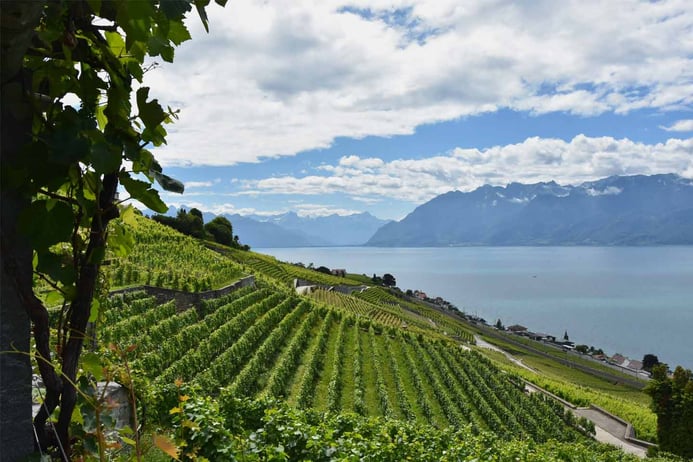The following article presents the highlights of a plenary session, moderated by EHL’s Prof. Steffen Raub, held on July 3, 2024 during the American Association of Wine Economists’ summer conference in Lausanne, Switzerland. EHL Hospitality Business School played host to the world’s leading wine economists and showcased the spectacular wine-producing regions, namely the Lavaux and the Valais.
The astounding variety in grape varieties in vineyards around the world
If you ask occasional wine consumers to name all the grape varieties they know, the list would maybe include a handful of names, including worldwide bestsellers like Chardonnay, Sauvignon Blanc, Cabernet Sauvignon or Shiraz/Syrah. Ask the same question to wine afficionados and they may come up with a list of three or four dozen, possibly more, including more exotic options like Semillon, Palomino, Mourvèdre or Mondeuse. However, the truly astounding fact about diversity in grape varieties is that there are upwards of a thousand of them that are planted around the world and used for wine production. One of the reference books in the domain, “Grape varieties”, coauthored by Jancis Robinson, Julia Harding and José Vouillamoz provides detailed information about almost 1400 varieties. 400 of them can be found in Italy alone.
At the recent conference of the American Association of Wine Economics (AAWE), held at EHL Hospitality Business School in July 2024, a panel discussion focused on diversity in grape varieties. Panel members included Kym Anderson (Professor Emeritus at the University of Adelaide and Vice President of the AAWE), Nicolas Depetris Chauvin (Associate Professor at HES-SO/Haute École de Gestion, Geneva), Michaël Schlegel (co-founder of SwissGrapes) and José Vouillamoz (Independent wine expert, writer and educator). The panelists tried to disentangle some of the benefits and drawbacks of having a diverse stock of grape varieties in a country’s vineyards. Hereunder we summarize some of the key insights that emerged from this panel for a broader audience of wine experts, wine growers, wine merchants, or simply wine lovers.
How diverse is the Swiss vineyard really?
As José Vouillamoz pointed out, the diversity of grape varieties in Switzerland is impressive at first sight. There are 252 grape varieties on record in Switzerland, out of which 168 are officially authorized in the Swiss AOC system. Adjusted for the modest vineyard size of just under 15.000 hectares, this diversity is even more impressive than the one in Italy. However, this picture needs to be put into perspective with actual production volumes. Close to 50% of the actual production is accounted for by only two grape varieties: Chasselas and Pinot Noir. Adding Gamay and Merlot to the picture one arrives at almost two thirds of the vineyard area. This means that, other than Chasselas, the production of the actual native grape varieties is rather anecdotal in quantity.
The marketing perspective
The diversity and strong presence of autochthonous grape varieties can be a double edged-sword from a commercial perspective, commented Michaël Schlegel. On the one hand, distinctiveness is intriguing and in particular international clients are attracted to this diversity and yearn to discover varieties they have never tasted before. It is what makes Swiss wines unique in their eyes. Conversely, this same diversity also makes it difficult to convey a strong identity for Swiss wines. Many successful wine producing countries or regions are clearly associated with a handful of dominant varieties (think Burgundy and Champagne for Chardonnay and Pinot Noir, New Zealand for Sauvignon Blanc or Australia for Shiraz). For Switzerland, such a clear association does not yet exist.
Nicolas Depetris Chauvin seconds this perspective. According to him, wine is not an element that comes to mind when consumers are asked about the imagery that Switzerland conjures. Switzerland as a country still tends to be associated primarily with cheese, chocolate and luxury watches. Plus, of course, the Swiss army knife. Kym Anderson confirms that he was surprised to learn that wine is even grown in Switzerland upon his first arrival in the country. He adds that an additional limitation to the marketing potential of native grapes is that they may be difficult to pronounce for international consumers.
The case for a stronger focus on “lieu dits”
The communication of the uniqueness of Swiss wine could be strengthened by a stronger focus on geographical origin and, more specifically, the uniqueness of clearly delimited “lieux-dits”, akin to the Burgundian notion of a “climat”, comments José Vouillamoz. Many Swiss wine regions possess well-documented historical maps of clearly outlined individual vineyards with specific names. However, unlike a Vosne-Romanée “Les Suchots” or a Saumur-Champigny “Le Brézé”, the historical vineyard names of Switzerland are not sufficiently communicated to be present in the consumers’ minds.

Panel discussion on the diversity in grapes varieties in the Swiss vineyards, at the AAWE Conference 2024, at EHL Campus Lausanne.
The quality-price paradox of Swiss wines
As some locals quip, Switzerland produces some of the most expensive simple wines but also some of the cheapest great wines in the world. The reasons behind this are manyfold. Vineyard holdings in Switzerland are on average rather small. The rugged terrain often makes it impossible to mechanize vineyard work. In combination with high labor costs this contributes to a total cost of production that does not put Switzerland in a position to compete on the world market for bottom-end or even mid-range wines. Conversely, at the top end of the market, one can find white, red and dessert wines of Swiss origin that compete with the greatest wines of the world. With the exception of some internationally known references (e.g. the Pinot Noir by famed producer Gantenbein), these wines still sell at very competitive prices. A clearer image for Swiss wine and more emphasis on the uniqueness of grapes and geographic origins may help these bottles to reach the price points they objectively deserve.
Let's not forget about oenotourism
Last, but not least, the diversity in the Swiss vineyard, combined with its often dramatic aspects and sheer beauty, suggests that another aspect should not be underestimated: the potential for oenotourism. Switzerland is a strong tourism destination with worldwide brand appeal. However, the attractiveness as a general destination has not yet been leveraged from the wine industry perspective. The objective here would be to lift wine to the level of national icons (alongside cheese and chocolate) and anchor in visitors’ minds that a trip to Switzerland is not complete without a tour of its vineyards and a tasting of its wines. Maybe an uphill battle at this point, but one that is worth fighting.






